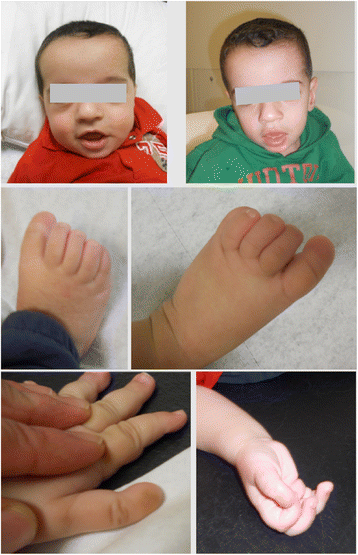Temple-Baraitser Syndrome and Zimmermann-Laband Syndrome: one clinical entity?
- PMID: 27282200
- PMCID: PMC4901505
- DOI: 10.1186/s12881-016-0304-4
Temple-Baraitser Syndrome and Zimmermann-Laband Syndrome: one clinical entity?
Abstract
Background: KCNH1 encodes a voltage-gated potassium channel that is predominantly expressed in the central nervous system. Mutations in this gene were recently found to be responsible for Temple-Baraitser Syndrome (TMBTS) and Zimmermann-Laband syndrome (ZLS).
Methods: Here, we report a new case of TMBTS diagnosed in a Lebanese child. Whole genome sequencing was carried out on DNA samples of the proband and his parents to identify mutations associated with this disease. Sanger sequencing was performed to confirm the presence of detected variants.
Results: Whole genome sequencing revealed three missense mutations in TMBTS patient: c.1042G > A in KCNH1, c.2131 T > C in STK36, and c.726C > A in ZNF517. According to all predictors, mutation in KCNH1 is damaging de novo mutation that results in substitution of Glycine by Arginine, i.e., p.(Gly348Arg). This mutation was already reported in a patient with ZLS that could affect the connecting loop between helices S4-S5 of KCNH1 with a gain of function effect.
Conclusions: Our findings demonstrate that KCNH1 mutations cause TMBTS and expand the mutational spectrum of KCNH1 in TMBTS. In addition, all cases of TMBTS were reviewed and compared to ZLS. We suggest that the two syndromes are a continuum and that the variability in the phenotypes is the result of the involvement of genetic modifiers.
Keywords: KCNH1; Temple-Baraitser syndrome; Whole genome sequencing; Zimmermann-Laband syndrome.
Figures


Similar articles
-
'Splitting versus lumping': Temple-Baraitser and Zimmermann-Laband Syndromes.Hum Genet. 2015 Oct;134(10):1089-97. doi: 10.1007/s00439-015-1590-1. Epub 2015 Aug 12. Hum Genet. 2015. PMID: 26264464
-
Epilepsy in KCNH1-related syndromes.Epileptic Disord. 2016 Jun 1;18(2):123-36. doi: 10.1684/epd.2016.0830. Epileptic Disord. 2016. PMID: 27267311
-
Syndromic disorders caused by gain-of-function variants in KCNH1, KCNK4, and KCNN3-a subgroup of K+ channelopathies.Eur J Hum Genet. 2021 Sep;29(9):1384-1395. doi: 10.1038/s41431-021-00818-9. Epub 2021 Feb 16. Eur J Hum Genet. 2021. PMID: 33594261 Free PMC article.
-
Temple-Baraitser syndrome with KCNH1 Asn510Thr: a new case report.Clin Dysmorphol. 2021 Jan;30(1):27-31. doi: 10.1097/MCD.0000000000000345. Clin Dysmorphol. 2021. PMID: 32956079 Review.
-
"Electrifying dysmorphology": Potassium channelopathies causing dysmorphic syndromes.Adv Genet. 2020;105:137-174. doi: 10.1016/bs.adgen.2020.03.002. Epub 2020 May 26. Adv Genet. 2020. PMID: 32560786 Review.
Cited by
-
Gain-of-Function Mutations in KCNN3 Encoding the Small-Conductance Ca2+-Activated K+ Channel SK3 Cause Zimmermann-Laband Syndrome.Am J Hum Genet. 2019 Jun 6;104(6):1139-1157. doi: 10.1016/j.ajhg.2019.04.012. Epub 2019 May 30. Am J Hum Genet. 2019. PMID: 31155282 Free PMC article.
-
Genetic architecture and phenotypic landscape of deafness and onychodystrophy syndromes.Hum Genet. 2022 Apr;141(3-4):821-838. doi: 10.1007/s00439-021-02310-2. Epub 2021 Jul 7. Hum Genet. 2022. PMID: 34232384 Review.
-
Potassium Channel KCNH1 Activating Variants Cause Altered Functional and Morphological Ciliogenesis.Mol Neurobiol. 2022 Aug;59(8):4825-4838. doi: 10.1007/s12035-022-02886-4. Epub 2022 May 31. Mol Neurobiol. 2022. PMID: 35639255 Free PMC article.
-
Antibodies Targeting KV Potassium Channels: A Promising Treatment for Cancer.Bioelectricity. 2019 Sep 1;1(3):180-187. doi: 10.1089/bioe.2019.0022. Epub 2019 Sep 16. Bioelectricity. 2019. PMID: 34471820 Free PMC article.
-
A new mechanism of voltage-dependent gating exposed by KV10.1 channels interrupted between voltage sensor and pore.J Gen Physiol. 2017 May 1;149(5):577-593. doi: 10.1085/jgp.201611742. Epub 2017 Mar 30. J Gen Physiol. 2017. PMID: 28360219 Free PMC article.
References
-
- Jacquinet A, Gérard M, Gabbett MT, Rausin L, Misson J-P, Menten B, et al. Temple-Baraitser syndrome: a rare and possibly unrecognized condition. Am J Med Genet A. 2010;152A:2322–6. - PubMed
Publication types
MeSH terms
Substances
Supplementary concepts
LinkOut - more resources
Full Text Sources
Other Literature Sources
Medical

